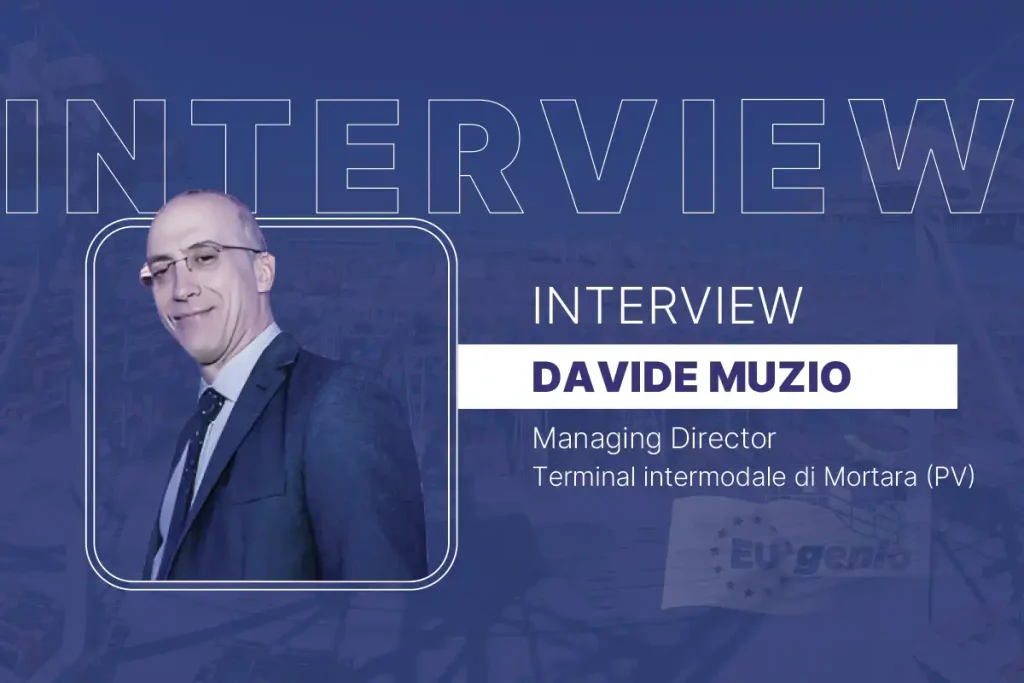The evolution of intermodal transport is revolutionizing the logistics sector, offering increasingly efficient and sustainable solutions for freight movement. In this article, we had the privilege of interviewing an industry expert to delve into the benefits, challenges, and future prospects of intermodal transport. The interview was conducted by Michele Marcolongo, editor of the PortaleGenio blog, the new platform dedicated to freight movement through intermodality.
1. Can you tell us a bit about your company and the sector in which you operate? How long have you been active in the market and what are your main services?
The Mortara Terminal was conceived in the late 1990s and became operational in 2008. After being connected to the RFI rail network in 2009, we had to manage the start-up phase, which was not easy for a private operator during the global crisis caused by the subprime collapse and the Lehman Brothers bankruptcy.
Over the years, the terminal has established itself as a model of excellence in the services offered, to the point that in 2023, German operator Kombiverkehr (one of the leading intermodal operators in Europe) decided to invest in the terminal’s management company, creating Kombi Terminal Mortara srl.
We offer the classic services of an intermodal terminal, primarily transshipment of loading units between trucks and trains. However, we stand out for the speed of these operations: for us, an average of 15 minutes between entry and exit is standard, whereas in other terminals times can be measured in hours. We also pay meticulous attention to train loading, planning every single unit in advance with our clients.
2. Can you explain what intermodal transport is and what its main advantages are over traditional transport methods?
Broadly speaking, intermodal transport involves the use of two or more modes of transport—for example, road-rail-sea.
More commonly, it refers to the road-rail combined transport system.
The core idea is that the loading unit travels the longest part of the journey by rail, and only the initial and final segments by road. The more the rail segment is utilized, the greater the economic and CO₂ emission savings.
Additionally, driver management can be optimized, as the loading unit travels unaccompanied on the rail portion and requires a driver and truck only for the first and last mile.
3. What emerging technologies are transforming intermodal transport?
Transshipment between trucks and trains is mainly carried out using gantry cranes (usually electric) or rubber-tired cranes (reach stackers), typically diesel-powered. Over the years, crane engines have made great strides in reducing pollution, and recently, electric and hydrogen-powered reach stackers have begun testing.
On the railcar side, progress has also been made: on one hand, railcars are being specialized for different load types; on the other, they’re becoming more versatile. Environmental improvements have included synthetic brake pads, which are less polluting and significantly quieter than cast iron ones.
In addition to traditional loading systems, horizontal loading solutions are being developed for non-craneable semi-trailers.
Another emerging topic is refrigerated unit power supply. Freight trains typically lack electrical power, so maintaining temperature—especially on long journeys—is a key success factor for rail transport of this type.
4. What are the main challenges intermodal transport faces today, and how can they be overcome?
Today, intermodal transport faces two major challenges:
-
Rail service quality: Due to EU recovery funds, many rail networks have launched infrastructure works, causing capacity constraints, interruptions, delays, and cancellations, which affect the reliability that was once the key strength of intermodality.
-
Energy costs: Driven by geopolitical instability (particularly the war in Ukraine), rail traction energy costs have risen significantly. While they have partially decreased since the initial peaks, they remain above pre-crisis levels.
The combination of higher costs and reduced reliability currently dampens the intermodal market.
However, the medium- to long-term outlook is positive. Infrastructure work will likely lead to increased capacity and improved overall performance of rail systems. Operators able to weather this period may benefit from a much more favorable future environment.
5. How does intermodal transport contribute to environmental sustainability?
Rail transport produces only about 10% of the CO₂ emissions compared to road transport. So, when the majority of the origin-to-destination journey is completed by rail, the reduction in harmful emissions is substantial.
6. What are the key factors to consider when choosing vehicles and routes for intermodal transport?
Typical loading units include containers, tank containers, swap bodies, and craneable semi-trailers. The choice depends on the type of goods.
As for routes and terminal selection, it’s best to maximize the rail segment and minimize the road segment. One must also consider the conditions offered by intermodal operators and the availability of terminals.
7. How can intermodal transport improve efficiency and reduce costs for companies?
This is a broad topic. Over long distances, combined transport can be less expensive than road transport. Additionally, intermodal transport avoids delays typical at Alpine crossings, which can greatly impact road transit.
For goods not requiring fast delivery, intermodal transport can act as a “moving warehouse”, enabling highly efficient supply chain management.
8. What are the future prospects for intermodal transport? What innovations can we expect in the coming years?
A fascinating question, but not an easy answer. Innovations may involve railcars and loading/lifting systems.
-
For railcars, powering freight cars electrically is under discussion, enabling connections for refrigerated or temperature-controlled units, which today run on diesel engines.
-
Cranes will become less polluting, moving toward hybrid, fully electric, or hydrogen-powered solutions. Additionally, new loading systems will allow lifting of non-craneable semi-trailers, which make up the majority of the current fleet—representing a large potential market.
9. How do you see the role of PortaleGenio in developing intermodal transport in the coming years?
PortaleGenio can be a very useful tool, especially for transport companies approaching intermodal markets. It offers an overview of intermodal operators, service lines, origin/destination terminals, and available exchange node services.
Intermodal remains a niche market, needing exposure to a broader audience. User-friendly tools that provide concise yet comprehensive information can help design logistic chains, which can then be formalized through agreements with relevant operators.
====
This interview provided a detailed and insightful look into the dynamics and potential of intermodal transport. We thank Eng. Davide Muzio for sharing his knowledge and vision.
PortaleGenio, through its app, aims to be a reference point for those seeking data and tools to optimize freight logistics and transport, contributing to a more efficient and sustainable future.


